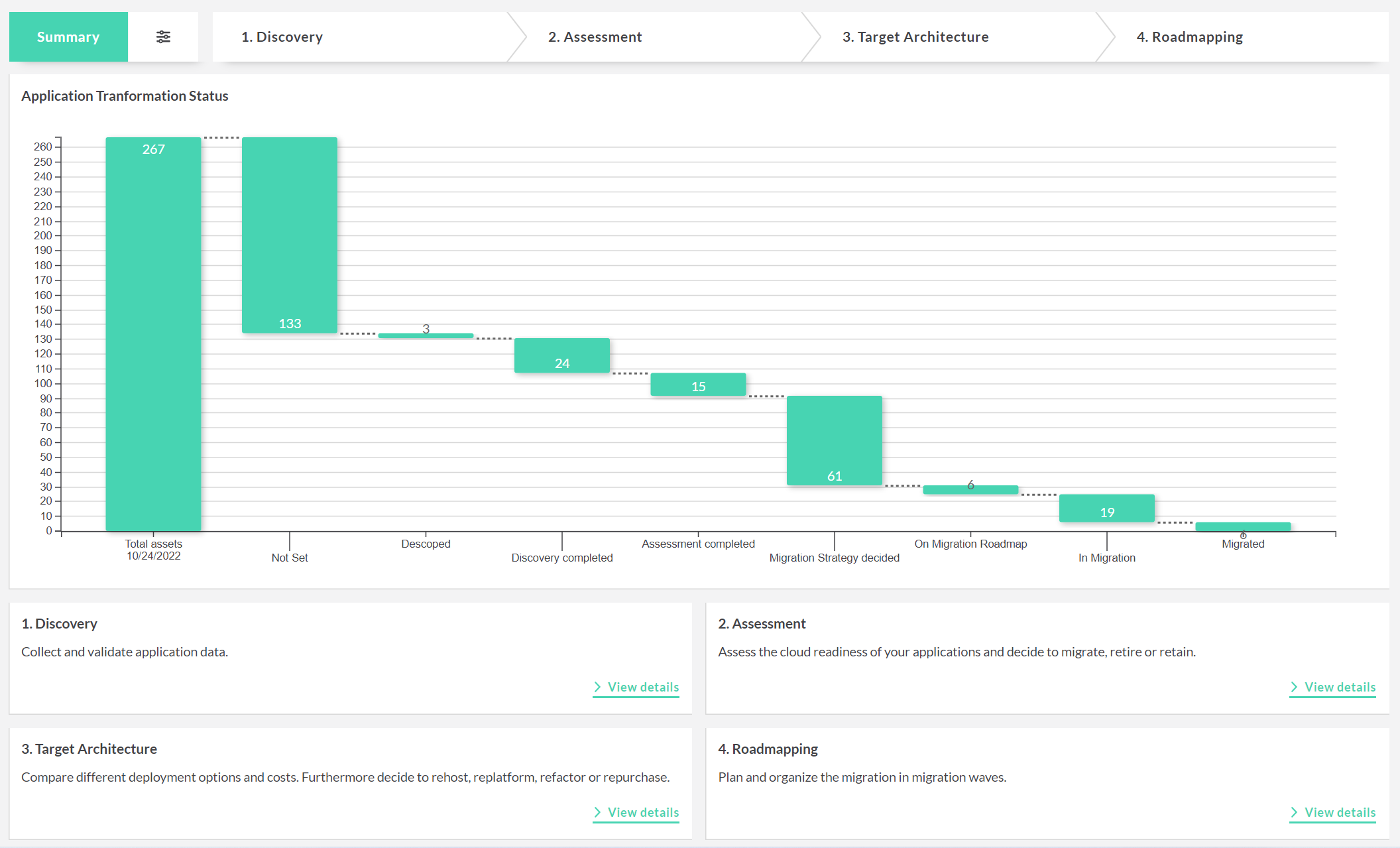Understanding your client's IT landscape before moving to the cloud

In every cloud transformation project, an essential first step is to get a thorough understanding of the current application landscape. But when the existing IT infrastructure is vast, and information is scattered among different units and data formats, this process can become excessively time consuming.
In this article, we will discuss:
- Why it is critical to understand the existing application landscape before defining a migration strategy
- The information you should collect in priority
- Common challenges during the data collection phase and best practices to overcome them.
Understanding the as-is application landscape: an essential first step of cloud transformation
Moving to the cloud can be highly beneficial for an organization, in terms of performance, agility, and, in some cases, cost efficiency. Nonetheless, in order to actually experience those benefits, good migration decisions must be made. This is why, before deciding on the most appropriate migration strategy for you or your client, you need a clear understanding of each existing application. For instance: what value does the application bring to the organization? What are its underlying technical components and how do they interact with each other? How confidential is the application’s data?
Once you have a thorough understanding of the application’s architecture and its benefits for the whole organization, you can make relevant decisions on how to move this application to the cloud.
The quality and completeness of data collection is thus critical for the success of your cloud transformation project.
Which information do you need to analyze your applications?
The main topics you should investigate regarding your applications include (but are not limited to):
General information & technical configuration
A substantial part of the data collection will consist of compiling data about the application’s technical properties and the way the application is deployed. Here are a few examples of what information you should look for:
- How the application has been developed or acquired (in-house technology, open source software, commercial off-the-shelf, etc.)
- The server or container infrastructure the application is running on
- The database where the data processed by the application is stored
- Middleware required to run the application
- Interfaces to other applications or IT services
- The geographical location of the application and the different deployment environments
- Whether licensing in the cloud is possible for this application
- The type of user interface: is it a desktop application or already a web application?
- The number of active users for this application
Application lifecycle
Determining the current state of the application is also important to plan your migration efforts. An obvious example would be: if you find out that the application is not relevant anymore and will be phased out in a few months, there is no need to migrate it.
Business Perspective
If you understand the value of an application for the organization, you will be able to choose the right cloud architecture for that application. An architecture that will allow the application, once in the cloud, to keep its value or even to be more efficient. It will also help you define whether this application should be moved to the cloud in priority. You should especially identify:
- The business capabilities / processes supported by the application
- The application’s criticality for business continuity
- Whether the application can support the organization’s innovation programs
You also need to consider which processes might be affected when migrating the application:
- Are there critical business processes that must not be interrupted?
- Which stakeholders will decide / can contribute to the application’s migration process?
Security
Security is a recurring concern for businesses when considering a cloud transformation. The final cloud architecture should comply with all relevant security and regulatory requirements. Thus, it is necessary to identify, for each application:
- Its level of confidentiality
- Whether it processes personal information
- Whether it processes organizational intellectual property
- How data is encrypted and transferred
Challenges and best practices for application landscape discovery
1 - Find all the data you need
The challenge In some organizations, data about the application landscape is organized in a very structured way. But in many cases, the data you need will be scattered among many different sources and formats, leading to a time-consuming data collection process. And sometimes, data will be missing outright.
Best practice
- Identify, as a first step, all the asset management solutions (such as CMDBs, in-house central data portfolios, enterprise architecture solutions, etc.) that will help you access structured information and accelerate the discovery phase.
- When data is missing or incomplete, stakeholders’ knowledge will be key. It is important to identify the relevant stakeholders beforehand and define which information they will be able to provide.
2 - Efficiently compiling all the collected information
The challenge Even when most of the important information is collected, you might have trouble compiling the data you have received from the different sources and stakeholders. The following issues can arise:
- Sometimes, you will receive contradictory information from different stakeholders (or data sources). You need to spot these “overlapping” situations to keep data quality high.
- The data might not be expressed the same way, depending on the source. For instance, application costs will be expressed monthly or yearly, depending on the case. Also, each data management solution (like CMDBs or infrastructure discovery tools) generally has its own way of annotating the different software and hardware solutions.
Best practice
- For the whole discovery process, you should use a unique data repository and a common data model. It will help you structure information, use the same pattern for every piece of data collected, and identify data gaps more easily. When gathering information coming from multiple data management solutions, it is important to normalize the information by using a central technology catalog.
3 - Keep data accurate over time
The challenge Suffice it to say: cloud transformations are long term initiatives, which means that the information about your applications will evolve over the course of your project. Therefore, it is crucial to ensure that data will stay accurate over time. Making your decisions based on obsolete data will lead to bad migration strategies.
Best practice
- To keep track of the intermediary changes, you should identify the master data sources and synchronize them so that the information will stay up-to-date. Again, it is critical to have a central repository to keep track of those changes.
See how Txture helps you develop a clear picture of your existing IT landscape and accelerate your cloud transformation
 Plan all phases of your cloud transformation project following Txture standardized methodology
Plan all phases of your cloud transformation project following Txture standardized methodology
The Txture platform helps you plan your journey to the cloud, from the cloud readiness assessment of your applications to the definition of your target architecture and the migration roadmap. The Txture platform helps you plan your journey to the cloud, from the cloud readiness assessment of your applications to the definition of your target architecture and the migration roadmap.
As a first step, Txture helps you accelerate data collection to assess your client’s existing IT landscape. As the information you need will be available in a variety of formats, Txture offers you several options to collect data more efficiently:
- A wide range of importers to streamline data collection from typical data sources (CMDBs, application portfolio management and EAM tools, etc.).
- Customized surveys to help you easily collect information from knowledgeable stakeholders when data is missing.
- A wide range of importers to streamline data collection from typical data sources (CMDBs, application portfolio management and EAM tools, etc.).
- Customized surveys to help you easily collect information from knowledgeable stakeholders when data is missing.
- Scheduled imports to keep your information up-to-date
All collected data is gathered in Txture’s central repository, where you can directly visualize the whole IT landscape. This helps you combine all the important information into one single source of truth, leading to more informed migration decisions and higher performance during your transformation project.
Seeing is believing!
Get started now - Our team will be happy to give you a first demo and answer your questions about the Txture Platform!
Looking for a short demo of how Txture facilitates the data collection process? Have a look at this video!
Related posts
14.11.2023Cloud MigrationSecurity risks of cloud computing11.5.2023
Modernization StrategyModernizing legacy IT applications30.3.2023
Cloud Migration Cloud Migration Overview | The 4 Phases & Best Practices6.12.2022
Cloud Target ArchitectureCloud Transformation: how to define the right cloud solution architecture16.11.2022
Cloud AssessmentReady, set, cloud: What is a cloud readiness assessment?
